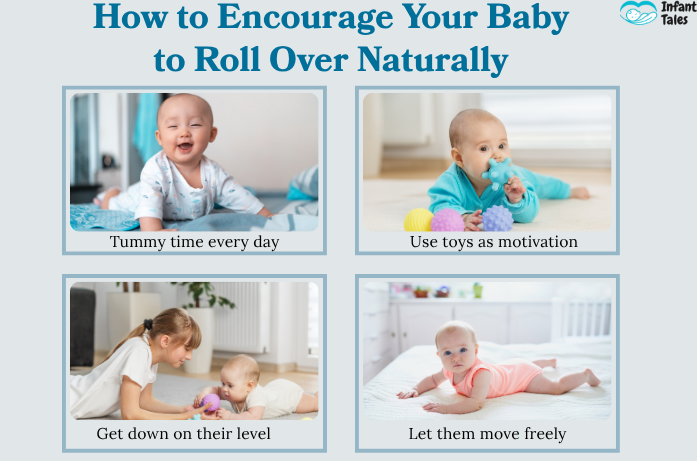By a Caring Mom at Infant Tales
Watching your baby achieve their first milestones is truly a unique experience. One day they’re just a tiny baby, barely able to lift their head, and before you know it, they’re moving, turning, and suddenly, surprise! they are rolling over. It is one of those lovely, heartwarming things that every parent keeps in their heart forever.
Rolling over is more than just an adorable trick; it’s a sign that your baby’s muscles and coordination are developing beautifully. It’s often one of the earliest entries in your baby milestones chart, showing their growing strength and independence. The parents are always eager for this first flip to happen because it implies that their little one is acquiring the ability to control movement and thus is in a position to progress to bigger stages like sitting up and crawling. If you are curious as to When Do Babies Roll Over, the short answer is usually between 3 and 6 months, but like every part of parenthood, there’s no single timeline.
According to experts at Pathways, each baby’s journey is unique, and comparing your baby’s progress to another’s isn’t necessary. Rolling over at their own pace is a normal and healthy part of development.
Understanding When Do Babies Roll Over Milestones
A baby rolling over is the first real step towards freedom of movement. They are suddenly able to change their position at will, and this is also their invitation to the world around them.
In general, babies perform the tummy-to-back roll first at about 3 to 4 months of age, which is very much in line with other 4-month baby development milestones such as better head control and longer tummy time. Back-to-tummy is generally seen around 5 or 6 months when the infant’s back and core muscles have gotten stronger.
This explains why some parents notice early movement in one direction but not the other. Some may even skip rolling completely and go straight to sitting or crawling later on both patterns are normal.
As BabyCentre UK notes, rolling isn’t just a physical milestone but also a step that supports sensory development, balance, and coordination, helping babies understand how their bodies move in space.
The Science Behind That First Roll
Rolling over is indeed a moment that looks pretty sweet but it is actually a complex physical process hidden behind it. Strength, coordination, and muscle memory, all of which are being developed through tummy time and daily movement, are required to roll over.
Supervised tummy time is strongly advised by pediatricians and experts from the American Academy of Pediatrics (AAP) right from the newborn stage because of the rationale that when a baby is on the tummy, they are indeed on the way to rolling over as they strengthen the neck, shoulder, arm, and core muscles required for pushing up and eventually rolling over.
Your baby has no idea but every little wiggle, kick, and push is helping them to practice these skills. All of a sudden your baby is able to push up with arms, twist the torso and shift the weight and this is the very foundation of all later gross motor skills like crawling and walking.
According to developmental experts at NIH, tummy time not only supports muscle growth but also prevents flat head syndrome and promotes early motor development.
Typical Timeline: When Babies Roll Over
While every baby follows their own timeline, it’s helpful to know general expectations from reliable sources like Help Me Grow Minnesota:
| Age (Months) | Developmental Stage |
| 0–2 months | Baby lifts head briefly during tummy time, building neck and shoulder strength. |
| 3–4 months | Rolls from tummy to back, first visible milestone of independence! |
| 5–6 months | Rolls both ways, using arms and legs together to control movement. |
| 6+ months | Travels through rolling as a means to discover the world and to change his location. |
Babies who enjoy tummy time and play a lot on the floor usually master rolling earlier than their peers. Babies who spend extended periods in bouncers or swings may take a little longer to master it, and that’s perfectly fine! No matter how long this stage lasts, it’s an integral part of your baby’s unique rhythm.
Signs Your Baby Is Ready to Roll Over
Before that first flip, you’ll notice exciting signs that your baby is getting close. These include lifting the head higher during tummy time, kicking legs more purposefully, rocking side to side, or twisting shoulders when lying on their back.
Babies usually get curious about movement around 3 to 4 months. The developmental stage of 4-month-old baby is filled with trial and error, the baby coming to the realization of being able to alter the position of his body. Your baby might even go halfway through the roll and then stop, laughing out loud as a result.
These efforts are indeed very good indications of baby’s development. The baby’s strength, coordination, and sense of body are gradually gaining, which are all crucial skills for rolling and crawling.

How to Encourage Your Baby to Roll Over Naturally
Teaching your baby to roll is not a necessary thing to do; he/she will learn it naturally through play and social interaction. Although, there are subtle yet safe ways to encourage it:
- Tummy time daily: Start from the newborn phase and gradually increase the duration. Babies who are given more tummy time become stronger and are thus able to roll over.
- Use toys as motivation: Place colorful toys or soft rattles just out of reach to encourage turning and stretching.
- Get down on their level: Recline next to your infant, grin, and chitchat, your voice and countenance are top motivators.
- Let them move freely: Don’t let your baby stay in swings or carriers for too long. The floor is the best place for them as it invites movement naturally.
The NAPA Center explains that these small, playful activities stimulate both the brain and body, promoting smoother and faster motor skill development.
When to Be Concerned About Rolling Delays
While it varies from baby to baby, most are able to roll over by the sixth month. In most cases, a little delay is normal, especially if your baby focuses on other skills like sitting or babbling. However, you should talk to your pediatrician if your baby:
- Not lifting or pushing his head by 4 months.
- Shows little movement in arms or legs.
- Feels very stiff or unusually floppy.
- Makes no effort to roll or move at all by 7 months.
These issues might indicate that a check-up for your baby would be a good idea, but sometimes all they need is more tummy time and encouragement.
For trustworthy guidance, the National Institute of Child Health and Human Development (NIH) offers reliable resources about baby motor development and typical milestones.

Rolling Over and Safe Sleep
Rolling over can bring big changes to your baby’s sleep routine, and it’s completely normal for parents to feel a bit anxious when it starts happening. According to the AAP’s “Back to Sleep” guidelines, you should always place your baby on their back to sleep. Once your little one can roll both ways on their own, it’s okay to let them settle in whatever position feels comfortable.
When your little one starts rolling both ways independently, it’s okay to let them settle into their preferred position. According to Red Nose Australia, once a baby can roll independently, parents shouldn’t reposition them, but should ensure the sleep space is safe free from pillows, blankets, and soft toys.
Supporting Muscle Development Through Daily Play
To make the process of rolling easier for your little one, simply give them time and space to move. No special equipment needed, just time for play and interaction.
- Tummy time: Every day, have several sessions, even for a few minutes each time.
- Floor play: A clean blanket or mat should be laid out so that the baby can freely stretch and wiggle.
- Gentle massage: Massages for babies help with their flexibility and body control.
- Encourage reaching: Place toys just out of reach to build motivation and strength.
All these activities together help your baby develop good muscle tone, body coordination, and confidence, preparing him for further tasks like sitting, crawling, and pulling up.
FAQs: Parents’ Common Questions
1. When do babies roll from tummy to back?
Rolling from tummy to back is a milestone most babies achieve between 3 and 4 months of age, while some may take longer depending on their strength and muscle development.
2. What if my baby only rolls one side?
This is perfectly normal, as babies typically choose to roll to one side first before learning to roll to both sides.
3. Is it possible to help my baby roll faster?
Sure, you can help with exercises like laying on their tummy, playing on the floor, and encouraging them; however, you should never force them. Let it happen naturally.
4. Should I be worried if my baby isn’t rolling by 6 months of age?
Not at all, but if your baby doesn’t make any attempts to move or lift their head, consult your pediatrician.
5. What if my baby rolls over while sleeping?
Once babies can roll both ways safely, let them sleep in the position they choose, just keep the sleep area clear and safe.
Final Thoughts
Turning over may seem like a small step; however, it’s one of the most important milestones in a baby’s early life. It marks the height of mobility, exploration, and independence.
It doesn’t matter whether this skill is learned at three months or six months; keep in mind that your little one is growing, learning, and gaining confidence every day. So, celebrate not just this milestone, but the journey, because every roll, turn, and giggle is part of your baby’s story.
Every little roll is a big step in your baby’s journey! Celebrate these precious milestones and keep learning with Infant Tales your trusted companion in parenting, growth, and baby care.
Follow Infant Tales for more real stories, expert tips, and milestone guidance every parent can relate to!
Disclaimer: This article is for informational purposes only and should not replace medical advice. If you have concerns about your baby’s growth or development, consult your pediatrician for guidance.



